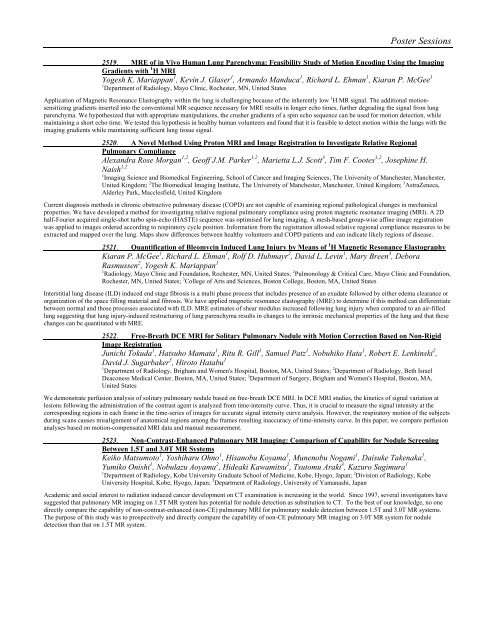TRADITIONAL POSTER - ismrm
TRADITIONAL POSTER - ismrm
TRADITIONAL POSTER - ismrm
Create successful ePaper yourself
Turn your PDF publications into a flip-book with our unique Google optimized e-Paper software.
Poster Sessions<br />
2519. MRE of in Vivo Human Lung Parenchyma: Feasibility Study of Motion Encoding Using the Imaging<br />
Gradients with 1 H MRI<br />
Yogesh K. Mariappan 1 , Kevin J. Glaser 1 , Armando Manduca 1 , Richard L. Ehman 1 , Kiaran P. McGee 1<br />
1 Department of Radiology, Mayo Clinic, Rochester, MN, United States<br />
Application of Magnetic Resonance Elastography within the lung is challenging because of the inherently low 1 H MR signal. The additional motionsensitizing<br />
gradients inserted into the conventional MR sequence necessary for MRE results in longer echo times, further degrading the signal from lung<br />
parenchyma. We hypothesized that with appropriate manipulations, the crusher gradients of a spin echo sequence can be used for motion detection, while<br />
maintaining a short echo time. We tested this hypothesis in healthy human volunteers and found that it is feasible to detect motion within the lungs with the<br />
imaging gradients while maintaining sufficient lung tissue signal.<br />
2520. A Novel Method Using Proton MRI and Image Registration to Investigate Relative Regional<br />
Pulmonary Compliance<br />
Alexandra Rose Morgan 1,2 , Geoff J.M. Parker 1,2 , Marietta L.J. Scott 3 , Tim F. Cootes 1,2 , Josephine H.<br />
Naish 1,2<br />
1 Imaging Science and Biomedical Engineering, School of Cancer and Imaging Sciences, The University of Manchester, Manchester,<br />
United Kingdom; 2 The Biomedical Imaging Institute, The University of Manchester, Manchester, United Kingdom; 3 AstraZeneca,<br />
Alderley Park, Macclesfield, United Kingdom<br />
Current diagnosis methods in chronic obstructive pulmonary disease (COPD) are not capable of examining regional pathological changes in mechanical<br />
properties. We have developed a method for investigating relative regional pulmonary compliance using proton magnetic resonance imaging (MRI). A 2D<br />
half-Fourier acquired single-shot turbo spin-echo (HASTE) sequence was optimised for lung imaging. A mesh-based group-wise affine image registration<br />
was applied to images ordered according to respiratory cycle position. Information from the registration allowed relative regional compliance measures to be<br />
extracted and mapped over the lung. Maps show differences between healthy volunteers and COPD patients and can indicate likely regions of disease.<br />
2521. Quantification of Bleomycin Induced Lung Injury by Means of 1 H Magnetic Resonance Elastography<br />
Kiaran P. McGee 1 , Richard L. Ehman 1 , Rolf D. Hubmayr 2 , David L. Levin 1 , Mary Breen 3 , Debora<br />
Rasmussen 2 , Yogesh K. Mariappan 1<br />
1 Radiology, Mayo Clinic and Foundation, Rochester, MN, United States; 2 Pulmonology & Critical Care, Mayo Clinic and Foundation,<br />
Rochester, MN, United States; 3 College of Arts and Sciences, Boston College, Boston, MA, United States<br />
Interstitial lung disease (ILD) induced end stage fibrosis is a multi phase process that includes presence of an exudate followed by either edema clearance or<br />
organization of the space filling material and fibrosis. We have applied magnetic resonance elastography (MRE) to determine if this method can differentiate<br />
between normal and those processes associated with ILD. MRE estimates of shear modulus increased following lung injury when compared to an air-filled<br />
lung suggesting that lung injury-induced restructuring of lung parenchyma results in changes to the intrinsic mechanical properties of the lung and that these<br />
changes can be quantitated with MRE.<br />
2522. Free-Breath DCE MRI for Solitary Pulmonary Nodule with Motion Correction Based on Non-Rigid<br />
Image Registration<br />
Junichi Tokuda 1 , Hatsuho Mamata 1 , Ritu R. Gill 1 , Samuel Patz 1 , Nobuhiko Hata 1 , Robert E. Lenkinski 2 ,<br />
David J. Sugarbaker 3 , Hiroto Hatabu 1<br />
1 Department of Radiology, Brigham and Women's Hospital, Boston, MA, United States; 2 Department of Radiology, Beth Israel<br />
Deaconess Medical Center, Boston, MA, United States; 3 Department of Surgery, Brigham and Women's Hospital, Boston, MA,<br />
United States<br />
We demonstrate perfusion analysis of solitary pulmonary nodule based on free-breath DCE MRI. In DCE MRI studies, the kinetics of signal variation at<br />
lesions following the administration of the contrast agent is analyzed from time-intensity curve. Thus, it is crucial to measure the signal intensity at the<br />
corresponding regions in each frame in the time-series of images for accurate signal intensity curve analysis. However, the respiratory motion of the subjects<br />
during scans causes misalignment of anatomical regions among the frames resulting inaccuracy of time-intensity curve. In this paper, we compare perfusion<br />
analyses based on motion-compensated MRI data and manual measurement.<br />
2523. Non-Contrast-Enhanced Pulmonary MR Imaging: Comparison of Capability for Nodule Screening<br />
Between 1.5T and 3.0T MR Systems<br />
Keiko Matsumoto 1 , Yoshiharu Ohno 1 , Hisanobu Koyama 1 , Munenobu Nogami 1 , Daisuke Takenaka 1 ,<br />
Yumiko Onishi 1 , Nobulazu Aoyama 2 , Hideaki Kawamitsu 2 , Tsutomu Araki 3 , Kazuro Sugimura 1<br />
1 Department of Radiology, Kobe University Graduate School of Medicine, Kobe, Hyogo, Japan; 2 Division of Radiology, Kobe<br />
University Hospital, Kobe, Hyogo, Japan; 3 Department of Radiology, University of Yamanashi, Japan<br />
Academic and social interest to radiation induced cancer development on CT examination is increasing in the world. Since 1997, several investigators have<br />
suggested that pulmonary MR imaging on 1.5T MR system has potential for nodule detection as substitution to CT. To the best of our knowledge, no one<br />
directly compare the capability of non-contrast-enhanced (non-CE) pulmonary MRI for pulmonary nodule detection between 1.5T and 3.0T MR systems.<br />
The purpose of this study was to prospectively and directly compare the capability of non-CE pulmonary MR imaging on 3.0T MR system for nodule<br />
detection than that on 1.5T MR system.















